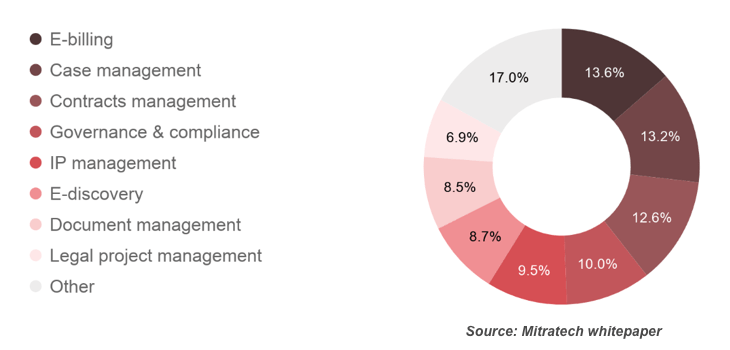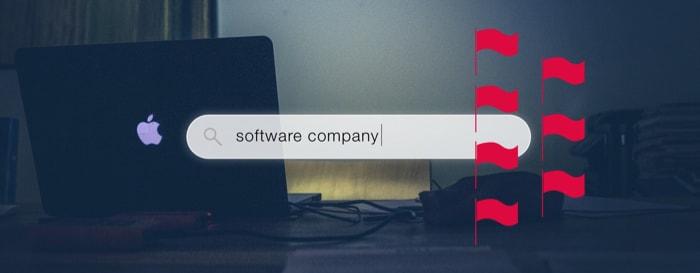
Automation and digitalization are coming to verticals across the board. But there is one industry where adoption of the latest technologies has been notoriously slow: the legal vertical.
According to a survey by Mitratech, legal firms and departments spend $3 billion a year on specialized software in the U.S. alone. At the same time, the potential U.S. market size is estimated at $15.9 billion. Hence, the average market penetration rate is still at 18.9%.
Let us see which legal software solutions are out there and how law firms can employ the latest technology to become more efficient.
Legal practice automation facets
The legal industry is made up of different types of companies and professionals. With respect to their software needs, we can roughly single out two kinds of users: legal firms and in-house legal departments.
Legal firms each have their specialization, but also share certain characteristics: they all have clients and some kind of workflow. At the same time, in-house legal departments are mostly concerned with contract management, governance and compliance, employee rights, IP management, and similar practices.
Law departments’ spend on third-party software

Needless to say, tech companies strive to automate anything that could be automated in the legal vertical. If we look at the technologies used, we’ll see a fair share of ORC (optical character recognition)-based, NLP (natural language processing)-based, search-based, predictive analytics-based, and even AI-based solutions.
Industry trends influencing software choices
To keep up with the technologically-advanced competition, many legal companies are looking to reinforce their software base. And investments in software are often driven by industry tendencies.
| Trend | Software requirement |
|---|---|
| The rise of tools that automate mundane tasks like contract review, among others. | Various automation solutions (like LawGeex) that reduce the time and effort for repetitive, low-risk tasks. |
| Corporations looking to save by bringing outside counsel in-house. | |
| New/stricter regulations like GDPR, HIPAA, etc. to comply with. | Compliance management software that lets one navigation applicable legislation and stay compliant (like Compliance.ai). |
| Digital data is now easier to create, so its amounts are growing exponentially. But attorneys still have the same time frames for preparing their cases as decades ago.* | Software that helps with e-discovery and legal research. AI-backed software (like Casetext) that picks out relevant information. |
According to research by IDC, the global amount of data produced annually is predicted to grow from 4 zettabytes in 2013 to 44 zettabytes by 2020. This makes tasks like legal research unprecedentedly complex, because one needs to consider not just a bigger pool of data, but also a greater variety of channels (like social media) and formats (like audio and video).*
Hence, it’s no surprise that the highest-growth segments of legal software are:
- Knowledge management
- Legal analytics
- Legal project management
- Contract management*
- Governance & compliance*
For these types of software, high growth also correlates to large potential market size (source – Mitratech whitepaper).
Software market overview
In its breakdown of legal software companies, Laconia Capital Group singles out four major types of vendor business models: Attorney Suite, B2C Legal Tech, Enterprise Legal Suite, and Law Firm Management Suite.
So, as you can see, there are technology companies that cater to corporate legal departments, law firms, solo practitioners, and even to individual clients that seek legal aid/advice/templates.
Some of the best known software products, many of which have become synonymous with entire subclasses of legal instruments, are:
- LexisNexis and Westlaw (legal research)
- Concord and Ironclad (contract management)
- AbacusLaw and Clio (case management)
- LawGeex (contract review and AI)
- Everlaw and AgileLaw (e-discovery)
- Compliance.ai (compliance management and AI)
- Avvo (legal aid B2C platform)
- Wevorce (divorce management software, B2C)
- Everplans and Willing (will drafting software, B2C and B2B)
- LegalZoom (legal form templates, B2C)
- Litify (practice management software)
Moving forward
According to the already-quoted Mitratech survey, the adoption of technology is still minimal across the legal industry, which is especially true of smaller corporate departments and legal firms. At the same time, smaller firms are the most vulnerable economically, since they can’t invest in technology as heavily as the big players.
Related Blogs

7 red flags to watch out for in a potential software vendor
LEARN MORE